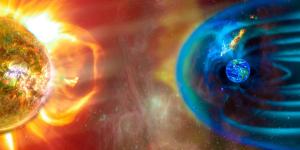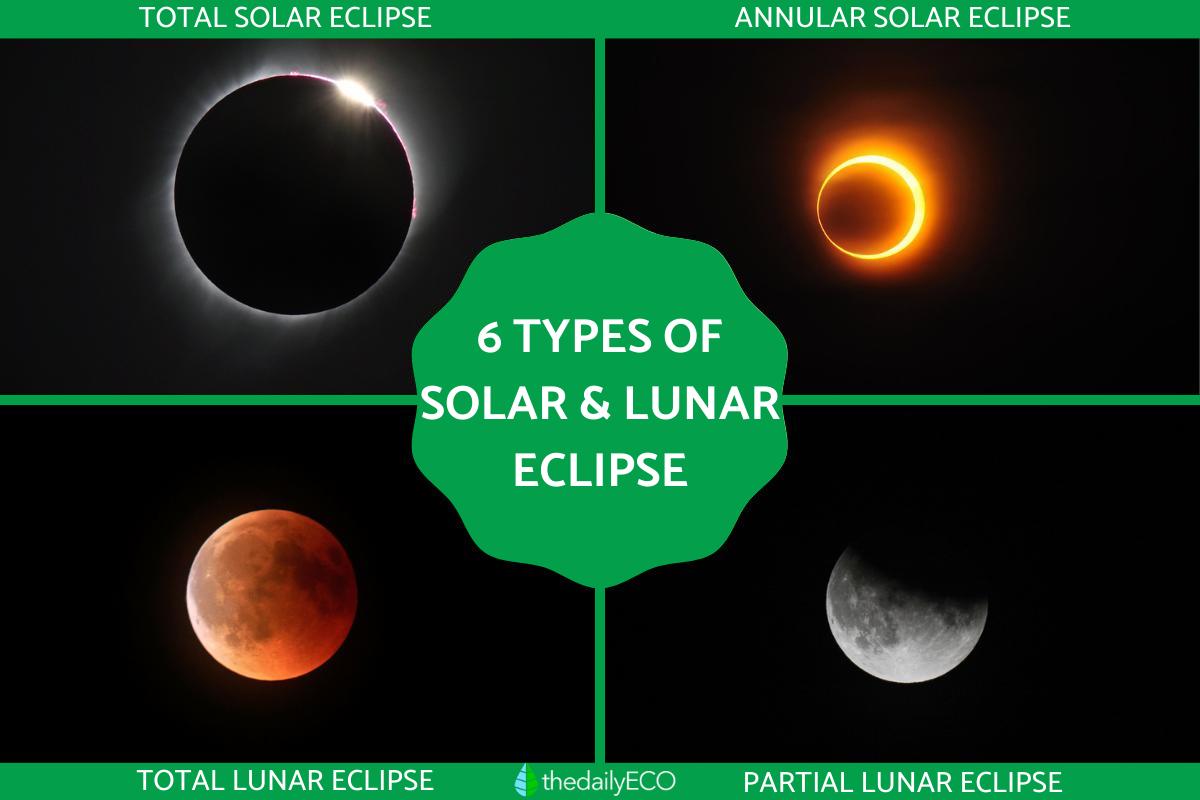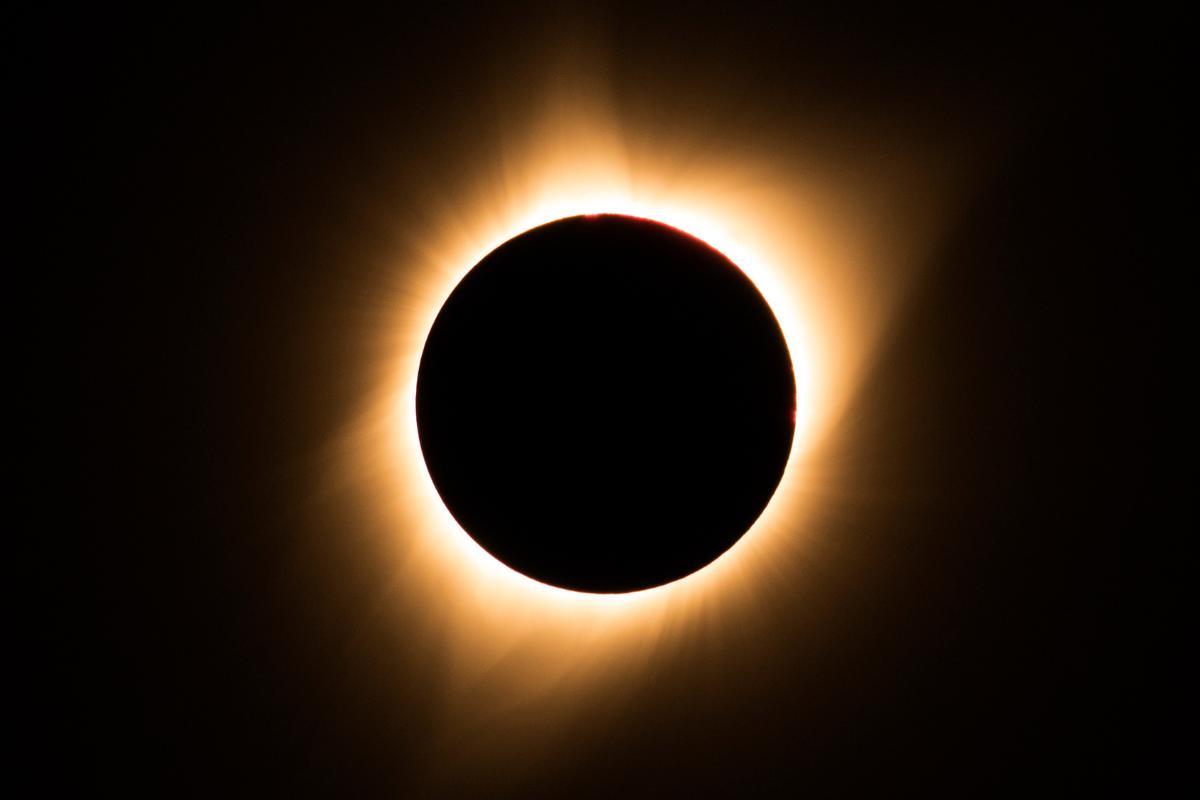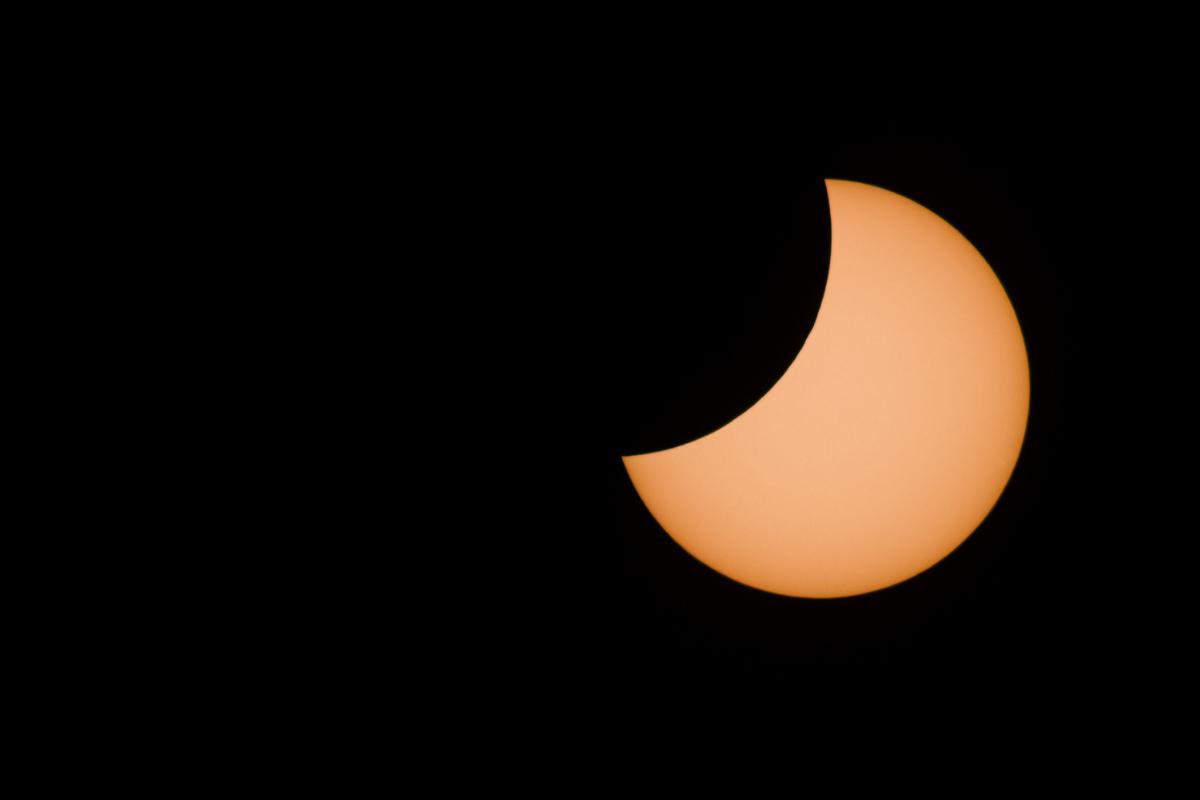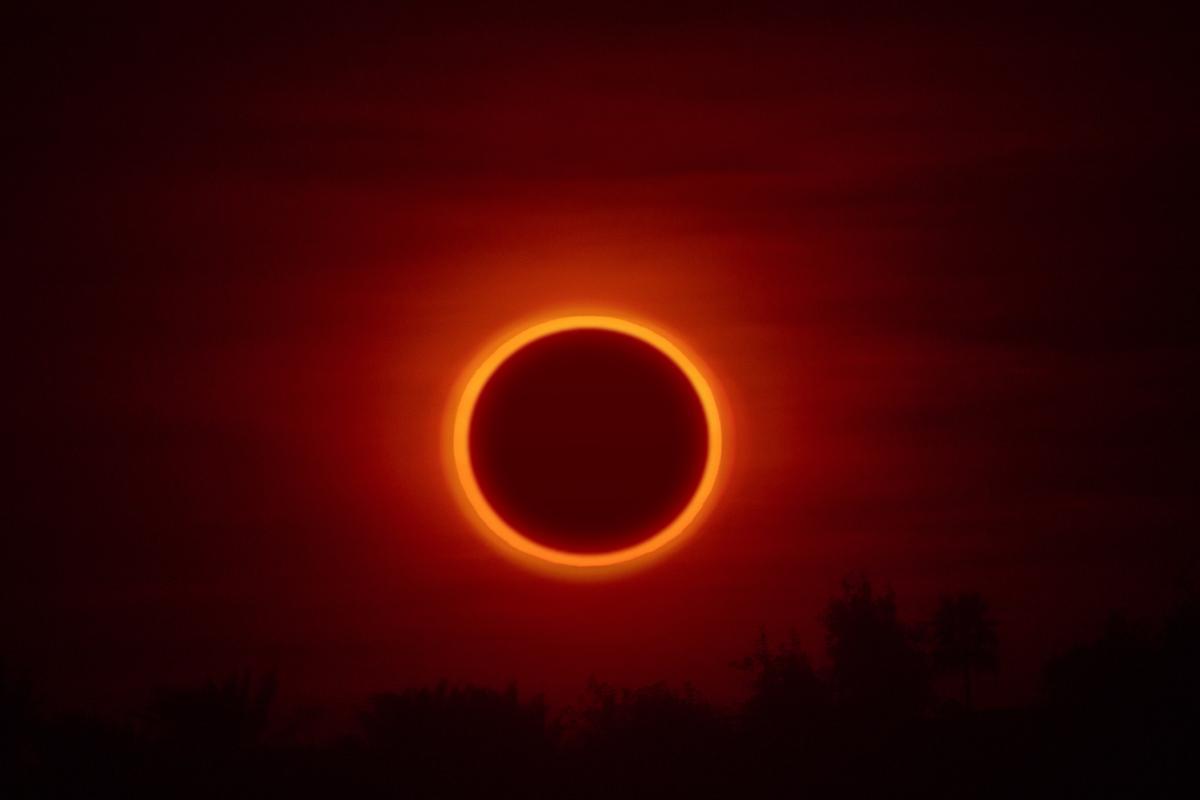Types of Eclipse - Solar and Lunar Eclipses


The different types of solar and lunar eclipses are total solar eclipse, partial solar eclipse, annular solar eclipse, total lunar eclipse, partial lunar eclipse and hybrid eclipses. Eclipses are phenomena that have intrigued humanity throughout history. They are astronomical events in which a celestial body comes between the Earth and a light source. Whether this light source is the Sun or the Moon will determine if it is a solar or lunar eclipse, respectively.
Although both solar and lunar eclipses share similarities in terms of their fundamental cause, they present significant differences in their appearance and in the processes that generate them. In this thedailyECO article, we provide the different types of eclipse, both solar and lunar. We explain their characteristics, as well as photos to see what they look like.
What is an eclipse?
An eclipse occurs when one celestial body moves into the shadow of another, creating a temporary alignment that obscures or darkens the light from the obscured body. There are two main types of eclipses:
Solar eclipse
A solar eclipse happens when the Moon passes between the Earth and the Sun, blocking all or part of the Sun's light. This occurs during the New Moon phase.
Lunar eclipse
A lunar eclipse occurs when the Earth passes between the Sun and the Moon, causing the Earth's shadow to be cast on the Moon. This happens during the Full Moon phase.
Significance of eclipses
Eclipses are significant astronomical events that have cultural, scientific and historical importance. They provide valuable opportunities for scientific observation and study. These include examining the Sun's outer atmosphere during a solar eclipse and studying Earth's atmosphere through the refracted light during a lunar eclipse.
Throughout history, eclipses have also played cultural and religious roles, often influencing myths, beliefs and rituals in different societies. Today, eclipses continue to captivate people worldwide, offering awe-inspiring celestial displays that bridge scientific curiosity and cultural fascination. Many people will gather to observe eclipses and they have become important community events.
Learning about celestial bodies from Earth is very difficult. Despite such complicated means of study, we can work out certain information such as the different layers of the sun by observing these astronomical phenomena.
Total solar eclipse
A total solar eclipse is one in which the Moon is positioned in such a way that it completely covers the surface of the Sun. In doing so, it generates a momentary dimming in a specific region of the Earth. Total solar eclipses are only visible from a relatively small geographical area on Earth. Due to the shape and size of the Moon and Earth, the Moon's shadow cast on Earth is quite narrow. Only those within this limited area can view the total eclipse.
Despite its complexity and preparation, the totality phase of a solar eclipse lasts only a few minutes This period is the time when the Sun is completely hidden behind the Moon and the solar atmosphere becomes visible.
Looking directly at the Sun can be very harmful to your eyes, even during a total solar eclipse. It is essential that certain precautions are taken. You should never look at the Sun without protection during a total or partial eclipse, as intense sunlight can cause irreversible eye damage.

Partial solar eclipse
A partial solar eclipse is one in which the Moon is positioned so that it only partially covers the surface of the Sun from the perspective of an observer on Earth. During a partial solar eclipse, the Moon does not completely block the Sun's disk, leaving a portion of it still visible, as is the case in the photo. The amount of coverage varies depending on the geographic location of the observer and the phase of the eclipse they are in.
Unlike total eclipses, partial solar eclipses are visible from a larger geographic region. Because it is not necessary to be within the narrow band of totality, many more people can witness a partial eclipse from different locations around the world.
Although a partial solar eclipse does not block the entire Sun, it is still necessary to take precautions when observing the event. Looking directly at the Sun during a partial eclipse without proper protection can cause eye damage.

Annular solar eclipse
An annular solar eclipse is another of the astronomical phenomena that occur when the Moon is aligned between the Earth and the Sun. In this case, it does not completely cover the solar disk, leaving a ring of visible light around its contour, as depicted in the photo below.
The most distinctive feature of an annular solar eclipse is the ring around the eclipse, commonly known as a ‘ring of fire’. When the Moon is at its farthest point from Earth in its elliptical orbit, its apparent size is slightly smaller than that of the Sun. As a result, during the maximum phase of an annular eclipse, the Moon covers most of the solar disk and leaves a ring of intense light around the lunar outline. This visual effect is impressive and unique compared to other types of eclipses.

Total lunar eclipse
A total lunar eclipse is one that occurs when the Earth comes between the Sun and the Moon, casting its shadow on the lunar surface and plunging the Moon into total darkness. Unlike total solar eclipses, total lunar eclipses are visible from any location on Earth where it is nighttime during the event. This is because the Earth's shadow is considerably larger than the Moon's shadow. Any night observer in the corresponding Earth hemisphere can enjoy the spectacle.
During a total lunar eclipse, the Moon does not disappear completely. Instead, it takes on a reddish or coppery hue. This is due to the scattering of sunlight by the Earth's atmosphere, which filters blue and green colors and allows red tones to reach the Moon. This coloration is often called a ‘blood moon’ and creates the stunning visual effect depicted in the photo below.
Learn more about how light affects the Moon's visibility with our article on why the Moon shines when it's dark.

Partial lunar eclipse
A partial lunar eclipse is one in which the Moon passes through the penumbra of the Earth's shadow. This results in a partial, but not complete, darkening of its surface. During a partial lunar eclipse, the Moon does not completely enter the Earth's dark shadow (umbra), but rather passes through its penumbra. This results in a partial darkening of the lunar surface, often with one part of the Moon appearing darker than the other. You can see this represented in the photo below.
Discover more about the types of Moon with our article on what is a Supermoon?

Hybrid eclipses
Sometimes known as an annular-total eclipse, a hybrid eclipse is rare and peculiar type of eclipse which has features of both total and annular solar eclipses. What makes an eclipse ‘hybrid’ is that its nature changes over the course of the event. It begins as an annular eclipse, creating the characteristics ring of fire since the Moon does not completely cover the Sun. It then becomes a total solar eclipse because the Moon completely blocks the Sun. The transition between these two phases can be rapid and amazing.
In the annular phase of a hybrid eclipse, the ring of fire around the Moon can be observed, similar to a typical annular eclipse. As the eclipse progresses toward the total phase, that ring gradually fades as the Moon completely covers the Sun.

How to observe different types of eclipses
Viewing any type of eclipse requires special precautions to avoid eye damage, but especially with solar eclipses. This is because the Sun's intense light can cause serious harm to your eyes if not viewed safely. Here are some methods to view an eclipse without damaging your eyes:
- Solar viewing glasses: use solar viewing glasses that meet international safety standards (ISO 12312-2). These glasses have special filters that block harmful solar radiation. Ensure they are not scratched or damaged, and follow the instructions provided.
- Pinhole projector: create a pinhole projector, which projects an image of the Sun onto a surface. You can make one using two sheets of paper or cardboard. Make a small hole in one sheet, let sunlight pass through it and allow the projected light to fall onto the second sheet.
- Solar filters for telescopes and binoculars: if you're using telescopes or binoculars, attach solar filters specifically designed for solar observation to the front aperture. Never look directly through these devices without proper solar filters.
- Solar viewing projector: build a solar viewer or projector using a telescope or binoculars. Project the Sun's image onto a screen or piece of white paper. Again, make sure the front end has a solar filter.
- Solar eclipse viewing apps: there are smartphone apps designed for safe solar viewing during eclipses. These apps use your phone's camera to project the Sun's image onto your screen, allowing you to view it indirectly.
Important tips when viewing types of eclipses
- Do not use regular sunglasses, CDs, DVDs or homemade filters to look directly at the Sun. They do not provide sufficient protection.
- Never use telescopes or binoculars without proper solar filters on the front end. Looking through them directly can cause severe eye damage.
- Take breaks during prolonged viewing to avoid eye strain.
Remember that safety is paramount when observing the Sun. Follow these precautions to enjoy the eclipse safely without risking harm to your eyes. Learn more about the Sun's light with our article on why is the Sun yellow?

If you want to read similar articles to Types of Eclipse - Solar and Lunar Eclipses, we recommend you visit our Facts about Earth and the universe category.




